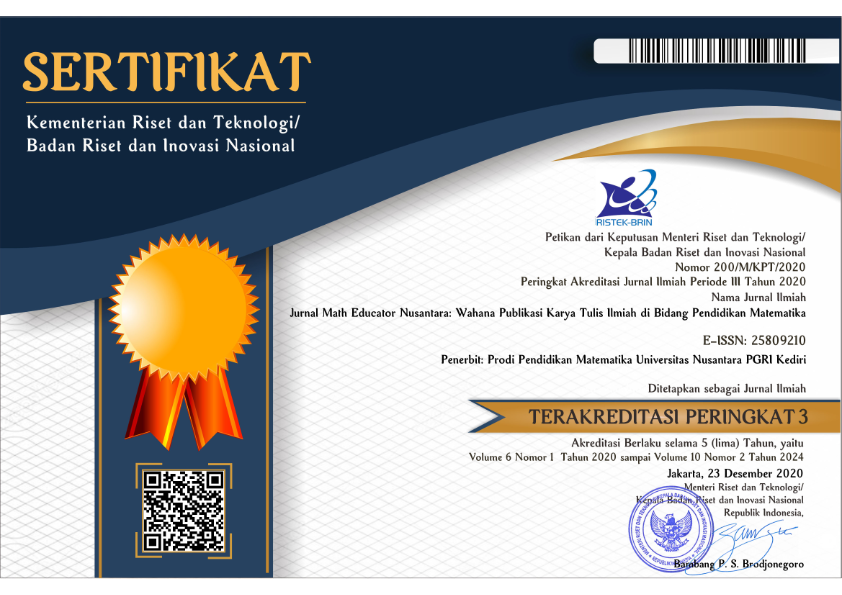Menghasilkan Lulusan Kreatif Melalui Pembelajaran Berbasis Masalah Kontekstual
creative thinking: contextual problem-based learning
DOI:
https://doi.org/10.29407/jmen.v3i2.856Keywords:
creative thinking, contextual problem-based learningAbstract
University development is inseparable from innovation. Innovations in various university components are aimed at producing graduates of the same quality. Quality graduates are produced through quality and measurable processes. Qualified graduates not only have intellectual intelligence which is indicated by high achievement index. Graduates of quality can also be demonstrated by the creative thinking ability of graduates in solving problems. Graduates creative one can be generated through contextual problem-based learning.
Keywords: creative thinking, contextual problem-based learning
References
Amabile, Teresa M.& Tighe, Elizabeth. (1993). Questions of Creativity. Dalam Brockman, John (ed.). Creativity. The reality Club 4. h. 7-27. New York: Touchstone, Simon & Schuster
Anderson, L.W., Krathwohl, D.R., Airasian, P.W., Cruikshank, K.A., Mayer, R.E., Pintrich, P.R., Raths, J., & Wittrock, M.C. (2001). A Taxonomy for Learning, Teaching and Assessing. A Revision of Bloom’s Taxonomy of Educational Objectives. New York: Addison Wesley Longman, Inc.
Bell, F.M. (1981). Teaching and Learning Mathematics (in Secondary Schools). Iowa: Wm. C. Brown Company Publishers.
Career Center Maine Department of Labor. (2001). Today’s Work Competence in Maine. Tersedia di http://www.maine.gov/labor/lmis/pdf/EssentialWork Competencies.pdf. Diakses 2 Pebruari 2011.
Dunlop, James. (2001). Mathematical Thinking. http://www.mste.uiuc.edu/courses/ ci431sp02/students /jdunlap/ WhitePaperII Download 1 November 2015
Dyer, J., Gregersen, H., Christensen, C.M. (2011). Innovators DNA: Mastering the Five Skills of Distruptive Innovators, Boston: Harvard Business Review Press.
Evans, James R. (1991). Creative Thinking in the Decision and Management Sciences. Cincinnati: South-Western Publishing Co.
Haylock, Derek. (1997). Recognising Mathematical Creativity in Schoolchildren. http://www.fiz.karlsruhe.de/fiz/publications/zdm ZDM Volum 29 (June 1997) Number 3. Electronic Edition ISSN 1615-679X. Download 7 Agustus 2012
Hurlock, Elizabeth B. (1999). Perkembangan Anak Jilid 2. (Alih Bahasa: dr. Med. Meitasari Tjandrasa). Jakarta: Penerbit Erlangga
Hwang, W. Y., Chen, N.S, Dung, J.J & Yang, Y.L. 2007. Multiple Representation Skill and Creativity Effect on Problem Solving Using a Multimedia Whiteboard System. International Forum of Educational Technology &Society Journal. ISSN 1435-4522
Isaksen, S.G. (1995). “CPS: Linking Creativity and Problem Solving”. In G. Kaufmann, T. Helstrup, & K.H. Teigen, (eds.) Problem Solving and Cognitive Processes: a festschrift in honour of kjell raaaheim (pp. 145-181). Berggen sandviken, Norway: Fagbolforlaget Vigmostad & Bjorke AS
Isaksen, Scott G. (2003). CPS: Linking Creativity and Problem Solving. www.cpsb.com. Download 23 Agustus 2015
Katminingsih, Y. dan Widodo, S. (2015). “Pengaruh Model Pembelajaran Berdasarkan Masalah Terhadap Kemampuan Berpikir Kreatif Matematis Siswa Ditinjau Menurut Gender Siswa SD Negeri Tarokan Kabupaten Kediri”. Math Educator Nusantara, Vol-1 (01) pp. 77-89 ISSN 2459-97345.
Krulik, S. and Rudnick, J.A. (1995). A New Sourcebook for Teaching Reasoning and Problem Solving in Elementary School. Massachussets: A Simon & Schuster Company.
Krulik, S., Rudnik, J. and Milou, E. (2003). Teaching Mathematics in Middle Schools. A Practical Guide. Boston: Pearson Education Inc.
Matlin, M.W. (1998). Cognition. Fort Worth: Harcourt Brace College Publishers
McIntosh, R., Jarret, D. & Peixono, K. 2000. Teaching Mathematical problem Solving: Implementing The Visions. (Online) (http://www.nwrel.org.), diakses 9 Agustus 2015
Meusburger P., Funke J. & Wunder E. (Eds). (2009). Milieus of Creativity: An Interdisciplinary Approach to Spatiality of Creativity. New York: Springer.
Munandar, U. (1999). Kreativitas & Keberbakatan. Strategi mewujudkan potensi kreatif & Bakat. Jakarta: Rineka Cipta.
Nakin, J.B.N. 2003. Creativity and Divergent Thinking in Education. Disertasi University of South Africa. (Online)(http://www.etd.unisa.ac.za), diakses 15 Agustus 2016
Pehkonen, Erkki (1997). The State-of-Art in Mathematical Creativity. http://www.fiz.karlsruhe. de/fiz/publications/zdm ZDM Volum 29 (June 2015) Number 3. Electronic Edition ISSN 1615-679X. Download 16 Agustus 2016.
Polya, G. (1973). How to Solve It. Second Edition. New Jersey: Princeton University Press.
Silver, Edward A. (1997). “Fostering Creativity through Instruction Rich in Mathematical Problem Solving and Thinking in Problem Posing”. Tersedia di: http://www.fiz.karlsruhe. de/fiz/publications/zdm ZDM Volum 29 (June 1997) Number 3. Electronic Edition ISSN 1615-679X. Diakses 19 Juli 2015
Siswono, T.Y.E., (2007). Penjenjangan Kemampuan Berpikir Kreatif dan Identifkasi Tahap Berpikir Kreatif Siswa dalam Memecahkan dan Mengajukan Masalah Matematika. (Disertasi tidak dipublikasikan). Universitas Negeri Surabaya.
Siswono, Tatag Y.E. (2008). Model Pembelajaran Matematika berbasis pengajuan dan pemecahan masalah untuk meningkatkan Berpikir Kreatif. Surabaya: University Press
Starko, Alane J. (2010). Creativity in the classroom: schools of curious delight. Fourth Edition. New York: Routledge Taylor & Francis.
Treffinger, D.J. & Isaksen S.G. 2005. Creative Problem solving: the History, Development, and Implication for Gifted Education and Talent Development. Gifted Child Quarterly, 49 (4): 342-353.
Toffler, A. (1980). The Third Wave. New York: Bantam Books.
Widodo, S. (2010). “Pembelajaran Matematika yang Mendukung Kreativitas dan Berpikir Kreatif”. Jurnal Pendidikan Matematika. Vol. 1 No.1 Januari 2010 Hal 43 – 53. Malang: UMM.
Widodo, S. (2015). Profil Berpikir Kreatif Guru Matematika SMP dalam Membuat Masalah Matematika Kontekstual berdasarkan Kualifikasi Akademik. (Disertasi tidak dipublikasikan). Universitas Negeri Surabaya
Widodo, S. (2013). “Variabel-Variabel Tersembunyi Dalam Guru Matematika Kreatif”. Prosiding Seminar Nasional Matematika dan Pendidikan Matematika. Sabtu 9 November 2013 di Universitas Negeri Yogyakarta. ISSN 978 – 979 – 16353 – 9 – 4
Downloads
Published
Issue
Section
License
Authors who publish with this journal agree to the following terms:
- Copyright on any article is retained by the author(s).
- The author grants the journal, the right of first publication with the work simultaneously licensed under a Creative Commons Attribution License that allows others to share the work with an acknowledgment of the work’s authorship and initial publication in this journal.
- Authors are able to enter into separate, additional contractual arrangements for the non-exclusive distribution of the journal’s published version of the work (e.g., post it to an institutional repository or publish it in a book), with an acknowledgment of its initial publication in this journal.
- Authors are permitted and encouraged to post their work online (e.g., in institutional repositories or on their website) prior to and during the submission process, as it can lead to productive exchanges, as well as earlier and greater citation of published work.
- The article and any associated published material is distributed under the Creative Commons Attribution-ShareAlike 4.0 International License
















